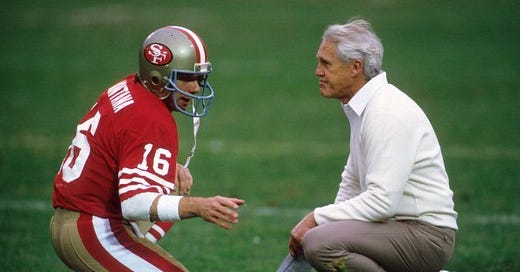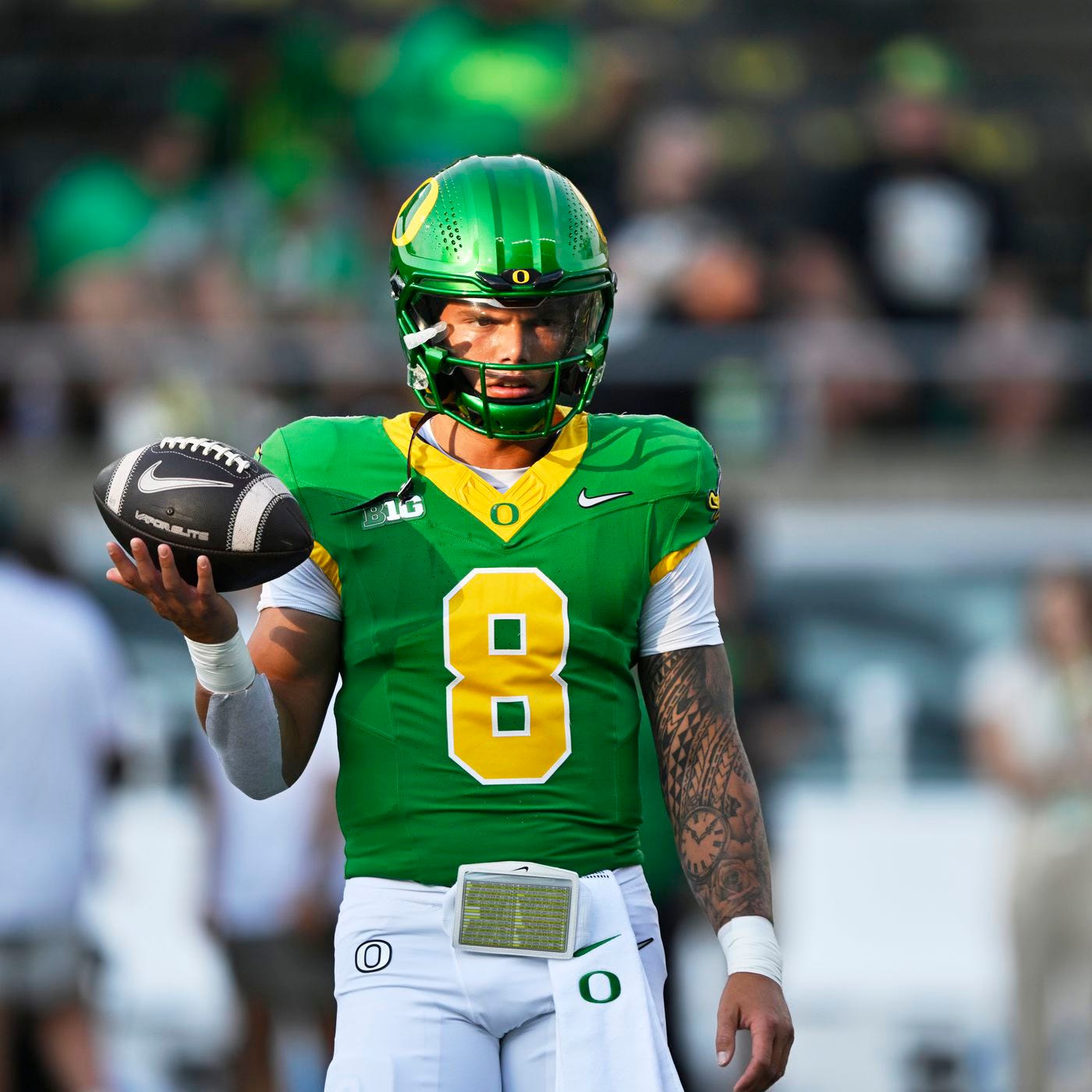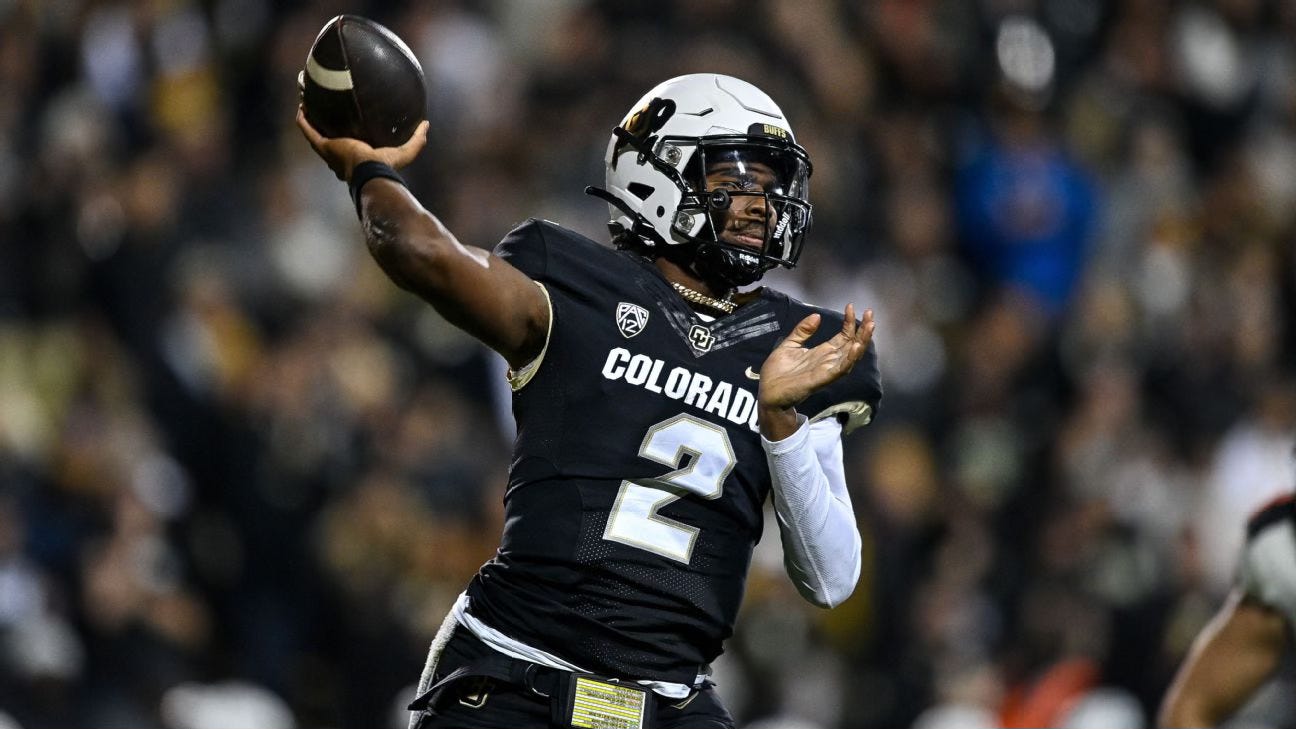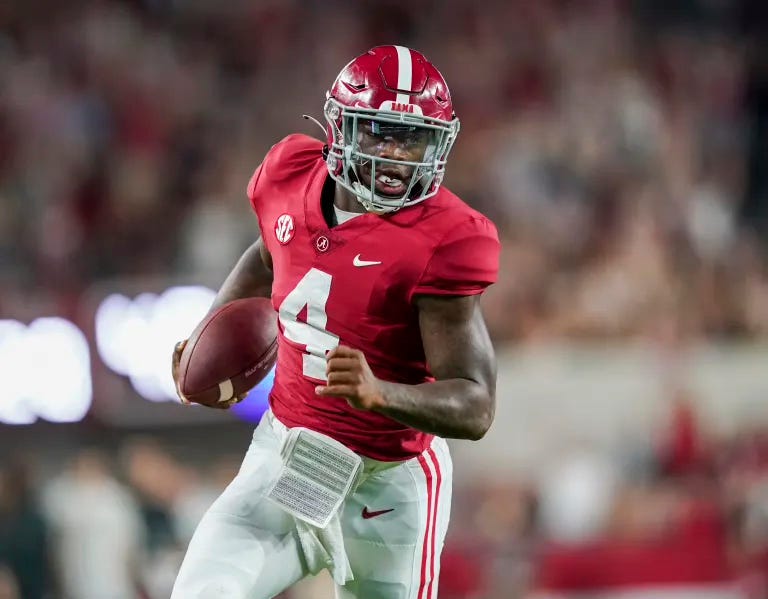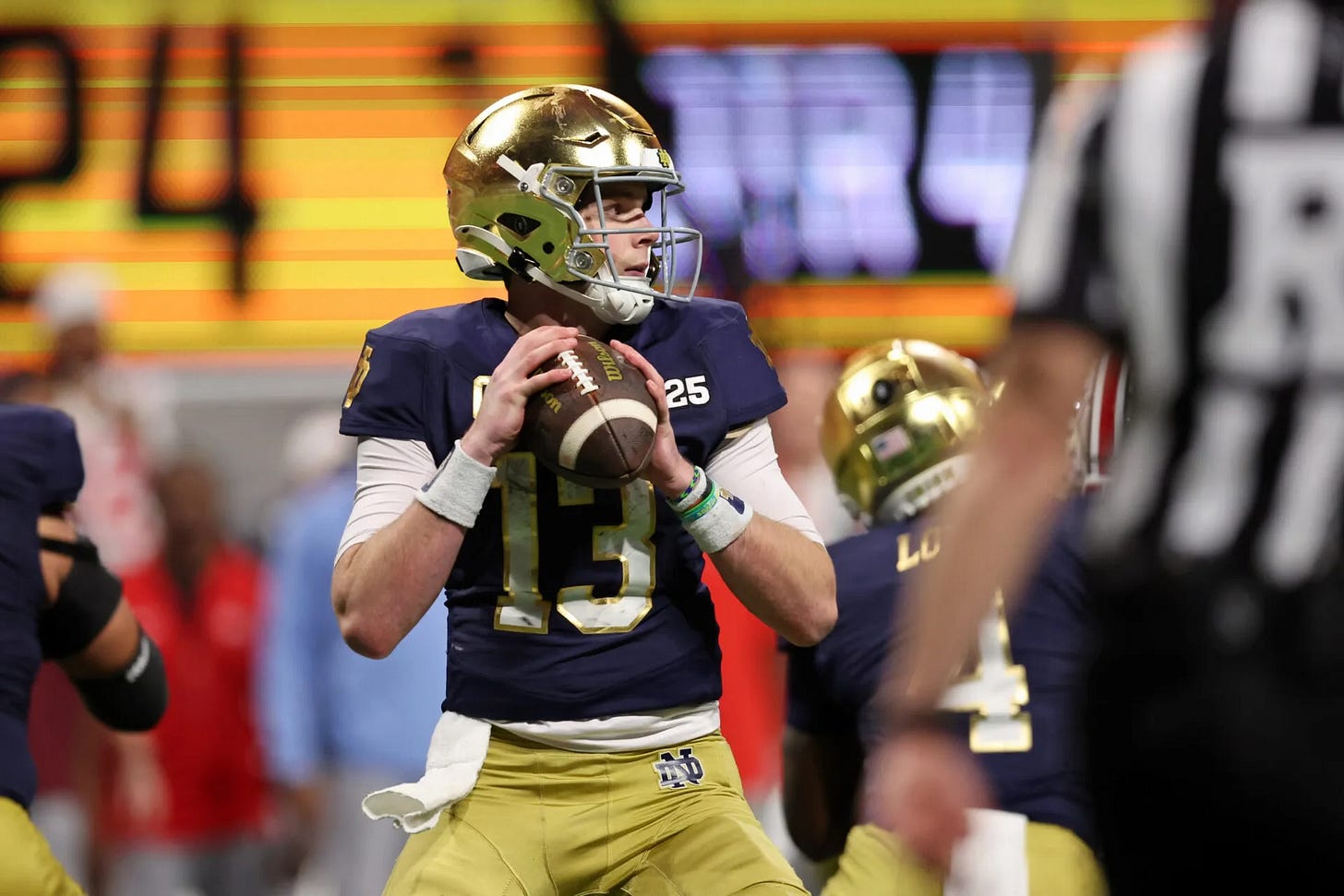The Quarterbacks
Scouting and stacking the 2025 rookie class - who rises, who falls, and who surprises.
“Call it an instinct, a second sense, a skill: The ability to peripherally feel the pass rush and see downfield is the very basis of NFL quarterbacking.”
- Bill Walsh, Building a Champion
Every quarterback is different, but quarterbacking in the NFL demands a blend of physical tools, mental acuity, adaptability, and resilience under pressure. There’s nothing else like it in sports and so it’s no wonder that the league has largely consolidated the presentation and rules of the game around the quarterback.
Football still remains the ultimate team sport, and a quarterback’s development and long-term success hinge on the ecosystem that surrounds them, same as their own capacity for adaptability. Does the organization have the right coaching in place? Are the franchise's administrators capable? Is the quarterback adaptable?
The Foundation of NFL Quarterbacking
At its core, elite NFL quarterbacking is about delivering in critical moments. Whether backed up to their own end zone or in the opponent's red zone with the game on the line, a quarterback must maintain poise and precision. This requires mastery of key elements,
Pre-snap Awareness: Winning before the ball is snapped, understanding the defense, and anticipating the play.
Pocket Management: Navigating active spaces to create throwing windows without pulling their eyes down to look at the rush.
Athleticism and Play Extension: The ability to escape pressure, keep their eyes upfield, and deliver accurate throws at all depths - even when off-platform.
Post-snap Awareness: Understanding the coverage that is expressed after the snap and where the advantages are in the play call.
Kinetic Chain and Footwork: Quick, repeatable mechanics rooted in efficient footwork are the foundation of velocity and accuracy.
Arm Talent and Mechanics
Contrary to how the media sells it, “arm talent” starts from the ground up. A quarterback’s feet use the ground to generate force which transfers up through the legs, rotating the hips and core. The arm follows along last in this process, with a complete follow through of the throw critical to accuracy and trajectory. A seamless kinetic chain is not just about power; it’s about repeatability under duress. Quick footwork enables a quarterback to “set and strike” swiftly, minimizing the defense’s opportunities for disruption.
Balanced feet also factor into quick, repeatable mechanics, but keep in mind this chapters first sentence - that every quarterback is different. Joe Montana self-admittedly didn’t have the world's strongest arm, and so he utilized a 70/30 stance, or, having 70% of his body weight on his back foot so he wouldn’t waste time going through the energy transfer from a 50/50 weight distribution. Aaron Rodgers could place accurate balls with good velocity from a “bunny hop”, while Patric Mahomes has the ability to generate velocity and accuracy from totally compromised footing.
While unconventional arm angles and shortstop-style throws can enhance a quarterback’s versatility, they are not prerequisites for success - Tom Brady, for instance, thrived with more traditional arm mechanics. What matters most is a quarterback’s ability to consistently deliver accurate, well-timed throws to shallow, intermediate, and deep targets - whether from a clean pocket or improvising under pressure. The assessment of mechanics that this document utilizes is how quick and repeatable is their velocity and accuracy from when their eyes lock onto their targeted receiver or space, to when the ball leaves their hand. If the player “windmills” or has drag in their throwing motion that defenders seem in-tune with, it will adversely impact my grade for them.
Individuality will make each quarterback’s kinetic chain different. Examples like Philip Rivers and Josh Allen highlight that there isn’t one "correct" motion - mechanics must suit the player’s physical and mental attributes. If there are any deficiencies in a quarterback’s throwing motion, it is not the end all be all. With current advancements in science, Josh Allen transformed his throwing motion through biometrics training with Chris Hess, and Jayden Daniels has had one of the most impressive rookie seasons of all time through a long, close partnership with Cognilize - A German VR company - loading exact stadium models into the simulation and running through that team’s specific forms of coverage and the variations of its looks at 1.75x speed.
Processing and the Mental Game
Processing speed is perhaps the most elusive trait to evaluate. A quarterback who hesitates - whether due to a lack of pre-snap recognition or post-snap indecision - allows the defense to dictate the play. A quick mind, paired with decisive action, separates good quarterbacks from great ones. Dane Brugler aptly stated on an Athletic Football podcast appearance during the 2024 draft season, "When you talk to teams about QBs, it’s the arm talent and physical traits that set the ceiling. It’s the interviews and board work that set the floor."
Unfortunately, I have no access to these interviews or the board work. What I can evaluate is what unfolds on film - the mechanics, decision-making, and ability to perform under pressure. This leaves key questions unanswered: Are they coachable? Trustworthy? Do they exhibit a relentless work ethic and a team-first mentality? While they sound like cheesy gestures from a by-gone era, Josh Allen and Drew Brees drastically altered their career trajectories by living and breathing the intangibles of coachability, work ethic, and mental toughness.
The 2025 Rookie Class
The 2025 quarterback class is a notable drop off from the 2024 class of Jayden Daniels, Drake Maye, Caleb Williams, Bo Nix, and Michael Penix. This isn’t to say that there aren’t any valuable prospects who can grow into franchise players with productive NFL careers, but that the quantity is considerably less by comparison. My assessment of the incoming prospects is as follows:
QB 1
Dillon Gabriel, Oregon Ducks
6’ 200
Overall Film Grade: B+
Footwork and Ball Handling: B
Pocket: A-
Accuracy: B
Mobility: A-
Durability: A+
Dillon Gabriel’s film might not scream superstardom, but it quietly offers the most refined and consistent tape in this quarterback class. Across a well-traveled college career, he was repeatedly asked to make a wide variety of throws and did so with rhythm, timing, and strong anticipation. The details are there: his release is compact and repeatable, his poise under pressure is steady, and his ability to keep the offense on schedule in hurry-up situations stands out. He doesn’t chase chaos, rarely forces the issue, and makes mature decisions whether that means checking it down, throwing it away, or working through his reads with composure.
Gabriel lacks the raw upside of Cam Ward or Shedeur Sanders and won’t be among the first quarterbacks off the board. But he plays with a high floor, polished fundamentals, and an understated command of the position that’s often overlooked in draft discourse. His feel for intermediate zone coverage and anticipation throws gives him a translatable skillset, and he shows a willingness to stay on script without being robotic. If he lands with a team willing to develop and utilize his strengths, it wouldn’t be surprising to see him outlast flashier names from this class and carve out a steady, successful NFL career.
QB 2
Cam Ward, Miami Hurricanes
6’2” 223
Overall Film Grade: B
Footwork and Ball Handling: C-
Pocket: B
Accuracy: B
Mobility: A
Durability: A+
Cam Ward’s college career reads like a tale of two quarterbacks. At Washington State under Ben Arbuckle, Ward was a sharp, decisive passer thriving in structure - capable of popping off big throws without losing rhythm or control. But his transfer to Miami felt more like a reluctant arrangement than a purposeful move, and it showed on the field. Despite not facing stiffer competition than the Pac-12 - a formidable conference in 2023 - Ward’s play in Coral Gables regressed in key areas: timing, accuracy, and decision-making. The details felt just off a quarter beat, and his tendency to hold the ball too long - bordering on stubbornness - undermined his natural gifts. The cockiness that once fueled his success began to cloud his situational awareness, leading to less efficiency and more frustration.
That said, Ward remains one of the most physically gifted quarterbacks in the draft, and his mental approach still flashes high-level potential. Quotes from Ward himself suggest a player who’s coachable and self-aware - someone who takes pride in the nuances of footwork, pre-snap reads, and chemistry with teammates. At his best, he processes quickly and delivers with confidence, and he hasn’t lost his edge under pressure. While I question the plateau we saw at Miami, I don't question the tools. Ward's ceiling remains immense, and if he lands in the right environment, it’s easy to see why he’s in the conversation as a top-3 pick and a potential QB1 off the board.
QB 3
Quinn Ewers, Texas Longhorns
6’2” 210
Overall Film Grade: B-
Footwork and Ball Handling: B
Pocket: D+
Accuracy: A
Mobility: F
Durability: F
Quinn Ewers is a poised and intelligent quarterback who excels in rhythm passing and demonstrates good accuracy, footwork, and ball placement on these quick throws. His ability to manage pressure in controlled situations and his mature understanding of coverage give him a solid foundation to build upon. However, his athletic limitations, cautious tendencies, and occasional lapses in decision-making may cap his upside at the next level. Ewers benefited significantly from returning for an additional year, showing growth in his game, but questions remain about his ability to push the envelope when needed. He missed a significant amount of time due to injury.
QB 4
Shedeur Sanders, Colorado Buffalo
6’1” 212
Overall Film Grade: C+
Footwork and Ball Handling: F
Pocket: D+
Accuracy: B+
Mobility: B
Durability: A+
Shedeur Sanders enters the NFL Draft with one of the most scrutinized resumes in recent college football. A two-time Offensive Player of the Year (SWAC and Big 12), Sanders holds school records at both Jackson State and Colorado, finishing his college career with over 11,000 passing yards and 107 touchdowns. But his play isn’t what you’d expect from Deion Sanders’ son - it’s less flashy athlete, more sturdy pocket passer with elite accuracy and toughness. His tape shows impressive poise under pressure, consistently delivering strikes despite porous offensive lines and absorbing a league-high number of sacks. While the media storm around the Sanders family - fueled by Deion’s bold personality, player turnover, and the controversial demotion of OC Sean Lewis - has often overshadowed Shedeur’s development, the quarterback himself has shown growth and flashes of NFL-level polish, particularly in his ability to manage the intermediate passing game and stand tall in chaos.
Still, there are clear areas for refinement. Sanders struggles with consistent footwork, disengaged play fakes, and a bad habit of holding onto the ball too long - often opting for “hero ball” instead of safer check-downs. His post-snap adjustments, ball security, and field maturity remain works in progress. Critics have questioned his leadership at times, though some of the character concerns seem overblown to me. Realistically, Sanders would benefit from a developmental year behind a veteran, but with his production, pedigree, and toughness, he’s likely to be thrust into a starting role right away. If protected and coached properly, his ceiling is considerable but his floor will depend on how quickly he sharpens the finer points of his game and matures as a decision-maker.
QB 5
Jaxson Dart, Ole Miss Rebels
6’2” 223
Overall Film Grade: C
Footwork and Ball Handling: C-
Pocket: C
Accuracy: C+
Mobility: F
Durability: A+
Jaxson Dart is a tough evaluation, in part because he’s spent his college career deeply embedded in Lane Kiffin’s vertical-heavy offense at Ole Miss - a scheme built around deep shots outside the numbers, with limited quick-game concepts or rhythm throws between the hashes. It’s unclear how he’d function in a system requiring precise timing or rapid progressions. Dart has consistently struggled with pressure in all its forms: late-game urgency, big-stage SEC matchups, and especially physical pressure in the pocket. He’s a limited athlete and not a reliable ball carrier, often resembling an old-school pocket passer, though without the prototypical frame once associated with that archetype.
His accuracy is solid - particularly deep - and his delivery functional, but there’s little beyond that to get excited about. While there are glimpses of anticipatory throwing, they’re few and far between - one throw against Kentucky stands out, but not much else. Dart presents as a low-ceiling, competent-floor type of quarterback who might benefit from a long runway behind a veteran mentor. Without that development time, it’s hard to see him emerging as anything more than a stopgap. If there’s a defining phrase for his future NFL broadcast tape, it might be: “Looks to run and gets taken down.”
QB 6
Jalen Milroe, Alabama Crimson Tide
6’2” 217
Overall Film Grade: D+
Footwork and Ball Handling: C-
Pocket: F
Accuracy: D+
Mobility: A-
Durability: A+
Jalen Milroe is one of the most electrifying athletes in this quarterback class, blending elite speed, quickness, and deep-ball arm strength to create constant big-play potential. His 2024 season at Alabama showed promising growth - particularly in pocket management and operational consistency - but Milroe remains a raw passer who thrives more on improvisation than structure. His ability to escape pressure and extend plays is elite, and when he connects on a deep shot, it forces defenses to stay honest. However, issues with rhythm, accuracy, and processing speed continue to limit his effectiveness as a traditional quarterback. He often holds the ball too long, struggles to diagnose defensive looks pre- and post-snap, and lacks polish on timing throws, especially in red-zone situations.
Milroe’s success at the next level will depend entirely on development. He’s not ready to start in the NFL, but with time behind a veteran quarterback and a creative offensive coordinator who builds around his dual-threat skill set, he has the potential to evolve into a dangerous weapon. Right now, his play style leans too heavily on athleticism and lacks the discipline required for consistent execution at the NFL level. If given the proper environment to refine his mechanics, processing, and maturity within an offense, Milroe could reward a patient team with long-term upside. As it stands, he’s a high-risk, high-ceiling Day 3 prospect who will need significant seasoning before he’s ready to lead a professional offense.
QB 7
Riley Leonard, Notre Dame Fighting Irish
6’4” 216
Overall Film Grade: D+
Footwork and Ball Handling: B
Pocket: F
Accuracy: D+
Mobility: A
Durability: D+
Riley Leonard is a fearless competitor with a physical edge and a running back’s mindset when he takes off - fast, strong, and capable of breaking tackles in the open field. He brings immediate value to an NFL team looking to build in RPO elements or designed QB run packages, where his decisiveness and confidence on quick throws can keep things on schedule. At both Duke and Notre Dame, Leonard thrived when the offense was pre-structured, allowing him to operate with rhythm on short and intermediate routes outside the hashes. His signature moment - a gritty upset over Clemson in 2023 - reflects the kind of toughness and leadership traits teams will gravitate toward.
That said, Leonard’s projection as an NFL passer is murky. His tape is full of batted passes, often the result of locking onto targets and failing to manipulate defenders with his eyes. He rarely worked through progressions, which made him easier to read and stalled offensive consistency. While he shows flashes of awareness and isn’t afraid to hold the ball for a potential second-window throw, the processing and polish just aren’t there yet. Injuries (ankle, turf toe) derailed parts of his 2023 season, and may have lingered into 2024. Leonard isn’t ready to start at the next level, but in the right system - with time, structure, and development - he could carve out a role as a situational QB or long-term backup with some upside. I wouldn’t be surprised if he was able to achieve even greater heights than my modest projection - he’s a unique competitor, body type, and arm.


